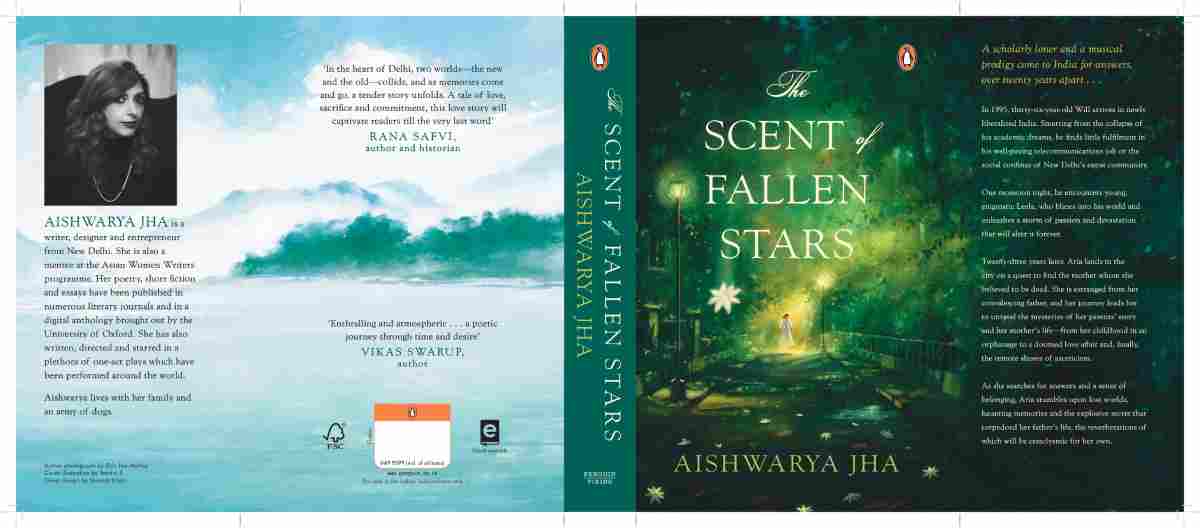By Neha Kirpal
Delhi -based writer, designer, and entrepreneur Aishwarya Jha’s debut novel, The Scent of Fallen Stars (Penguin, 2024), is a poignant love story set against the backdrop of India’s liberalisation in mid-1990s.
In 1995, 36-year-old Will arrived in Delhi from England. One monsoon night, the intoxicating fragrance of the maulsari flower, “blooming in the secret recesses of the night”, leads him to encounter the young and beautiful Leela, a meeting that will change their lives forever. As Leela begins giving Will Hindi lessons, he falls hopelessly in love with her, only to learn that she is engaged to marry someone else soon.
Twenty-three years later, Aria arrives in Delhi to explore her roots and uncover the truth about her mother, whom she believes to be dead. The novel shuffles between past and present as Aria unravels the mysteries of her family’s past, including her mother’s childhood in an orphanage, her doomed love affair, and her subsequent journey into asceticism.
Also read: Green gems of Delhi: New book chronicles city’s public gardens
Aishwarya’s narrative weaves a rich tapestry of love, loss, and discovery, making The Scent of Fallen Stars a compelling read for those captivated by tales of romance and family secrets.
The inspiration for her novel came during a late-night monsoon walk.
“The rain had stopped, but the roads were still gleaming, mist stretched between the trees, softening and moulding the glow from the streetlights. The fragrance of my favourite Indian flower, the maulsari, kept catching me, arresting my progress like an intoxicant. Suddenly, I heard a faint humming. When I stopped and looked back, I could almost see this figure in white floating along the avenue I had just covered, humming her song, lost in her reverie. The entire scene unfolded before me, with all its emotion and atmosphere, and I knew I had to capture it,” Aishwarya explains.
The story evolved in Aishwarya’s mind, encompassing themes close to her heart. She wrote it in parts, with a long break in between, taking about eighteen months to complete the first draft.
Through her lyrical writing, she pays tribute to the capital city.

“Two cities seemed to exist simultaneously: the ungainly metropolis on the ground, engorged with aesthetic atrocities, and the spectacular dreamscape of the city in the sky,” she writes.
The novel, set largely in Delhi, paints a vivid picture of the city, frequently referencing well-known landmarks and monuments, particularly in the Lutyens’ zone, such as Lodhi Gardens, Humayun’s Tomb, Golf Club, Khan Market, Sujan Singh Park, Amrita Shergill Marg, and Jor Bagh.
Her novel brings Delhi to life with its rich, evocative descriptions of the city’s landscapes and seasons. Set against the backdrop of India’s mid-1990s liberalisation, the novel explores the intertwining lives of its protagonists while celebrating the multifaceted character of the Capital.
Aishwarya captures the city during festive seasons like Dussehra and Diwali, with their vibrant pandals, and reminisces about an old Delhi “fragrant with the exhilaration of climbing mango trees, drinking Vimto, and swimming in the Yamuna before it turned into a toxic sump”.
The novel also mentions various iconic neighbourhoods and landmarks, such as the legendary Wenger’s bakery in Connaught Place, Hailey Road, Curzon Road (now KG Marg), Jama Masjid, St. James’s Church, Nehru Park, Chandni Chowk, Imperial Hotel, Priya Cinema, Deer Park, Nizamuddin, Lodhi Colony, and Vasant Vihar.
Through her protagonists, Aishwarya skilfully describes Delhi’s changing seasons. For instance, she portrays March in the Capital as “offering glimpses into a utopian world of flowers blooming on roundabouts, welcoming sunshine and temperatures so pleasant,” contrasted with May, when “the line between slow and certain death was thinner here than anywhere else”.
Aishwarya’s deep personal association with Delhi shines through her narrative.
“Delhi is unlike any other place, and it will always be home,” she says. Although she initially yearned to leave the city and chase the “American dream” promised by Hollywood movies and comic books, her perspective changed after moving away at fifteen.
“I realised how, underneath the sludge and tedium, lay this beautiful, unconquerable tangle of history, character, and petrichor,” she reflects. Upon her return, she knew she was home for good.
Another significant setting in the book is Rishikesh, where Aria discovers her mother had lived as an ascetic. The author vividly portrays the holy town with its “semi-naked sadhus” amid the blue waters of the Ganges and “ashrams teaching yoga and other schmaltzy spiritual disciplines to every variety of seeker”.
The novel also delves into the intricate relationships between mothers and daughters, a theme close to Aishwarya’s heart.
“This story certainly would not exist without the inspiration and example of my mother, the wisest of teachers, dearest of companions, and most awe-inspiring of beings,” she writes in the book’s acknowledgments.
Looking ahead, Aishwarya reveals that her next novel will be a departure from her debut, venturing into Gothic fiction.
“It’s set in a Himalayan town and explores the other side of relationships, the secrets and betrayals that eat away at the root of what we consider family. Watch this space for more!” she concludes.





